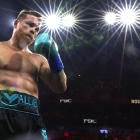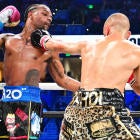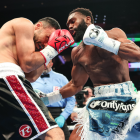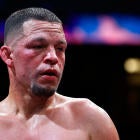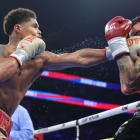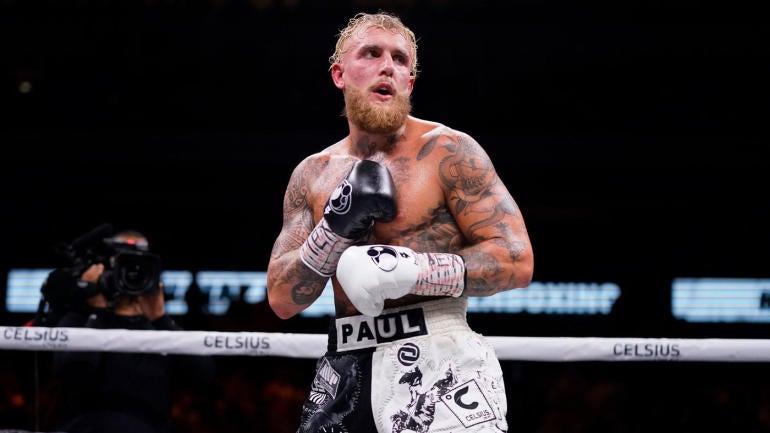
Jake Paul's return to the boxing ring on Saturday to face unheralded "professional boxer" Andre August is, in its way, the most normal step in Paul's entirely unique professional boxing career. Not surprisingly, Paul fighting a boxer of questionable quality has drawn criticism from many, as has nearly every decision for Paul's professional opponents.
The fight with August (10-1-1, 5 KO) will be Paul's ninth professional boxing match (live on DAZN, 7:30 p.m. ET). For reference, Floyd Mayweather Jr. an Olympic medalist and the greatest boxer of his era, fought Jesus Chavez in his ninth pro bout. Chavez entered the bout with a record of 1-13-1. Manny Pacquiao fought 8-9-5 Rudolfo Fernandez in his ninth fight. Saul "Canelo" Alvarez faced 0-1 Daniel Martinez his ninth time out.
That is to say, Paul is not doing anything out of the ordinary in facing an opponent many view as a "light touch" this early in his career when it comes to standard boxing logic and August may outpace the level of opposition for many elite fighters at this stage in their careers. Of course, Paul is already a massive star, both from his social media background and from a boxing career featuring primarily big names from the world of entertainment and mixed martial arts.
By most accounts, Paul has truly dedicated himself to his boxing career, attempting to improve his skills and build himself into an actual contender. And, by becoming a more skilled boxer -- however limited those skills may be -- Paul has lost something of an edge in how he fights, no longer operating as a reckless brawler looking to land viral one-punch knockouts and instead trying to actually outbox opponents.
Can't get enough boxing and MMA? Get the latest in the world of combat sports from two of the best in the business. Subscribe to Morning Kombat with Luke Thomas and Brian Campbell for the best analysis and in-depth news.
The above situations have created something of a two-pronged problem for Paul as he attempts to navigate pleasing the audience both in opponent selection and in providing entertainment when he steps through the ropes.
The opponent selection problem
The demands on Paul have always been complicated. Knocking out fellow influencer AnEsonGib and turning former NBA star Nate Robinson into a meme with a brutal knockout were fights where Paul was dipping his toe into the boxing game while still staying firmly planted in the entertainment world. A fight with former MMA champion Ben Askren was supposed to be a step toward legitimizing his career, but Askren showed up horribly out of shape before being knocked out.
Former UFC champion Tyron Woodley managed to take one scorecard in their first meeting but was flattened with a brutal hook in the rematch. At this point, the calls for Paul to face a "real boxer" increased.
To be fair, Paul did make an immediate and clear jump in opposition. His next fight was against UFC great Anderson Silva, who had defeated former world champion Julio Cesar Chavez Jr. in a boxing match. Paul knocked Silva down and took a clear decision.
He followed that win up by facing Tommy Fury, who was the first "real boxer" Paul had faced in his career. The fight was close but Paul came up short by split decision, even after scoring a knockdown. The loss to Fury was a reality check for Paul, who fought at a much slower, more measured pace.
Fury has proven to be a low-ceiling fighter, barely edging past Paul and again struggling to a win against another influencer in KSI. But he does have more experience training in the sport than Paul.
After clearly beating MMA superstar Nate Diaz in his most recent fight, Paul had to make a decision. The well was drying up on available former UFC stars to carry a pay-per-view card with Paul and the demands that Paul test himself against men who have spent considerable time training and competing as professional boxers became more and more legitimate if Paul actually wanted to advance toward a future status as a contender, even if fighters like Silva were technically better than many fighters face in their seventh professional fight.
This led to August getting the call as someone with a nice enough looking record on paper but also enough vulnerabilities -- he was stopped by a 3-3 opponent who has gone 3-13 since -- in 2018.
Paul can either fight crossover fights that can do bigger business but provide less development or he can face fighters like August, who aren't likely to draw big numbers or provide much excitement but put him on a path more reflective of a young fighter trying to gain experience in the ring.
Skills over excitement
Paul's early knockout wins showed that he had natural power in his shots. These weren't light stoppages, they were thunderous knockout shots.
He has now gone three fights without a stoppage, though he did score knockdowns in those fights with Silva, Fury and Diaz. There's still power there, though it may not be quite as shocking as Paul's early career knockouts made it seem.
This drop in power seems to be due, in part, to Paul focusing more on a technical approach to boxing. Around the Woodley fights, Paul began leaning more on his jab and less on whipping hard lead hooks and overhand rights with full power behind them.
This may actually be encouraging as it would show that Paul is working to become a better boxer, as well as having encountered in-ring fatigue that led to him needing to be more conservative with his energy, especially as he was fighting eight and 10-round fights earlier than most boxers.
Fighting a less exciting style can make a fighter less of a hot commodity and lead to a drop in overall interest. If Paul isn't producing knockouts that dominate social media and he is fighting opponents with no name value, no matter how much both of those things may be better for his overall development as a boxer, it will be very interesting to see what Paul's career looks like in a year, and how much people care to keep paying attention.









